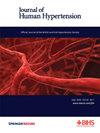Correlation between different types of obesity and hypertension in perimenopausal working women
IF 3.4
4区 医学
Q2 PERIPHERAL VASCULAR DISEASE
引用次数: 0
Abstract
Hypertension (HTN) can lead to a series of target organ damage and is associated with increased cardiovascular disease incidence and mortality. Perimenopause implies an important physiological transition. Previous studies have confirmed that obesity is a risk factor for the development of HTN. Nevertheless, few studies have investigated the prevalence of HTN in perimenopausal women and the relationships between peripheral or abdominal obesity and HTN. Therefore, we analysed the influencing factors of HTN in perimenopausal working women and the correlation between different types of obesity and HTN to provide evidence for the need to prevent HTN in perimenopausal women. Perimenopausal women who underwent physical examination at Shanghai Health and Medical Center from January 2021 to October 2021 were selected as subjects. A multivariate logistic regression model was used to analyse the associations between different types of obesity and HTN in perimenopausal women. Five hundred eighty-two perimenopausal women were included in this study; 124 cases of HTN were detected (incidence rate 21.31%), 23 of which were isolated systolic HTN (18.55% of total HTN cases). Multivariate logistic regression analysis revealed that age and BMI were the influencing factors of HTN in perimenopausal women. Compared with that of perimenopausal women without peripheral obesity, HTN in overweight (OR = 1.84, 95% CI: 1.13–2.98) and peripheral obesity (OR = 4.36, 95% CI: 1.52–12.54) women increased with increasing body weight. Perimenopausal women with abdominal obesity had a greater risk of developing HTN (OR = 2.69, 95% CI: 1.16–6.21) (P < 0.05). Age and BMI are risk factors for the development of HTN in perimenopausal working women. Both abdominal obesity and peripheral obesity are positively associated with HTN in perimenopausal women. The BMI and abdominal circumference of perimenopausal women need to be monitored as early as possible to prevent obesity and reduce the occurrence of HTN.围绝经期职业妇女不同类型肥胖与高血压的相关性研究。
高血压(HTN)可导致一系列靶器官损伤,并与心血管疾病发病率和死亡率增加有关。围绝经期意味着一个重要的生理转变。先前的研究已经证实,肥胖是HTN发生的危险因素。然而,很少有研究调查围绝经期妇女HTN的患病率以及外周或腹部肥胖与HTN之间的关系。因此,我们分析围绝经期职业妇女HTN的影响因素以及不同类型肥胖与HTN的相关性,为围绝经期妇女预防HTN的必要性提供依据。选择2021年1月至2021年10月在上海市卫生医疗中心接受体检的围绝经期妇女作为研究对象。采用多变量logistic回归模型分析围绝经期妇女不同类型肥胖与HTN之间的关系。582名围绝经期妇女参与了这项研究;共检出HTN 124例(发生率21.31%),其中孤立性收缩期HTN 23例(占总HTN的18.55%)。多因素logistic回归分析显示,年龄和BMI是围绝经期妇女HTN的影响因素。与围绝经期无外周性肥胖的妇女相比,超重(OR = 1.84, 95% CI: 1.13-2.98)和外周性肥胖(OR = 4.36, 95% CI: 1.52-12.54)妇女的HTN随体重增加而增加。围绝经期腹部肥胖的妇女发生HTN的风险更高(OR = 2.69, 95% CI: 1.16-6.21)
本文章由计算机程序翻译,如有差异,请以英文原文为准。
求助全文
约1分钟内获得全文
求助全文
来源期刊

Journal of Human Hypertension
医学-外周血管病
CiteScore
5.20
自引率
3.70%
发文量
126
审稿时长
6-12 weeks
期刊介绍:
Journal of Human Hypertension is published monthly and is of interest to health care professionals who deal with hypertension (specialists, internists, primary care physicians) and public health workers. We believe that our patients benefit from robust scientific data that are based on well conducted clinical trials. We also believe that basic sciences are the foundations on which we build our knowledge of clinical conditions and their management. Towards this end, although we are primarily a clinical based journal, we also welcome suitable basic sciences studies that promote our understanding of human hypertension.
The journal aims to perform the dual role of increasing knowledge in the field of high blood pressure as well as improving the standard of care of patients. The editors will consider for publication all suitable papers dealing directly or indirectly with clinical aspects of hypertension, including but not limited to epidemiology, pathophysiology, therapeutics and basic sciences involving human subjects or tissues. We also consider papers from all specialties such as ophthalmology, cardiology, nephrology, obstetrics and stroke medicine that deal with the various aspects of hypertension and its complications.
 求助内容:
求助内容: 应助结果提醒方式:
应助结果提醒方式:


